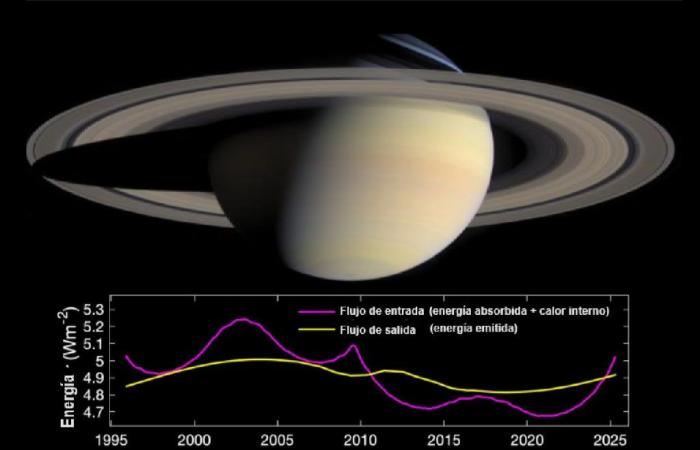A breakthrough discovery by researchers at the University of Houston (UH), published in the scientific journal Nature Communications, has revealed a huge energy imbalance on Saturn, challenging what is known about science and planetary evolution, as well as existing climate models for the gas giants of the solar system.
“This not only allows us to better understand the formation and evolution of planets, but also changes the way we think about planetary and atmospheric sciences.
“This is the first time that a global energy imbalance on a seasonal scale has been observed in a gas giant,” said Liming Li, professor of physics in the College of Natural Sciences and Mathematics at the University of Houston.
Saturn discovery challenges science of planets and atmosphere
Using data from the Cassini probe mission, Xinyue Wang, a third-year doctoral student in the Department of Earth and Atmospheric Sciences at NSM, discovered a significant and previously unknown seasonal energy imbalance on Saturn.
“All planets receive energy from the Sun in the form of solar radiation and lose it by emitting thermal radiation,” Wang said. “But Saturn, like other gas giants, benefits from another energy input in the form of deep internal heat, which affects its thermal structure and climate.
This imbalance is due to Saturn’s large orbital eccentricity, which varies by nearly 20% between aphelion and perihelion. This is why Saturn’s seasons last for several years.
This imbalance is due to Saturn’s significant orbital eccentricity, which varies by almost 20% between aphelion (the point of the orbit furthest from the Sun) and perihelion (the point of the orbit closest to the Sun), which results in huge seasonal variations in absorbed solar energy.
Our planet Earth, unlike Saturn, does not experience significant seasonal energy imbalance due to its very low orbital eccentricity.
“The Earth has a measurable energy budget, but it is mainly determined by the solar energy absorbed and the thermal energy emitted,” said Xun Jiang, professor of atmospheric sciences. “The internal heat of the Earth is negligible and its seasons last only a few months, while those of Saturn last several years.”
Saturn’s Giant Storms
Data from this recent research also suggest that Saturn’s energy imbalance plays a key role in the development of giant storms, which are a dominant meteorological phenomenon in the planet’s atmospheric system.
These data found on Saturn could also provide information about the Earth’s climate.
“As far as we know, The role of the energy budget in the development of moist convective storms on Earth has not been fully examined, “That’s why we plan to study this issue as well to see if there is a link,” Wang said.
Reassessing atmospheric models
The Cassini mission, the result of an ambitious collaboration between NASA, the European Space Agency and the Italian Space Agency, was launched in 1997 and explored Saturn, its rings and moons for nearly 20 years.
According to the UH statement, Professor Li was selected as a participating scientist in the monitoring of three onboard instruments observing Saturn’s radiant energy balance.
Wang, along with fellow graduate students Larry Guan (physics) and Thishan D. Karandana G and Ronald Albright (earth and atmospheric sciences), conducted the study, advised by Professors Li and Jiang.
“In current models and theories regarding the atmosphere, climate and evolution of gas giants, “The global energy budget is supposed to be balanced,” Wang said.
“But we believe our discovery of this seasonal energy imbalance requires a reevaluation of these models and theories.”
Li’s team is now looking at other gas giants, including Uranus, where a flagship probe mission is planned within the next decade.
“Our data suggest that these planets will also exhibit significant energy imbalances, especially Uranus, which we predict will have the greatest imbalance due to its very high orbital eccentricity and obliquity,” Mr. Wang said.
“What we are studying now will help identify constraints on current observations and formulate testable hypotheses that will benefit this future flagship mission.
In addition to UH researchers, The study’s authors include scientists from NASA, the University of Wisconsin, the University of Maryland, the University of Central Florida and the University of California, Santa Cruz, as well as scientists from France and Spain.
Article reference:
Wang, X., Li, L., Jiang, X. et al. Cassini spacecraft reveals global energy imbalance of Saturn. Nat Commun 155045 (2024). DOI: 10.1038/s41467-024-48969-9






